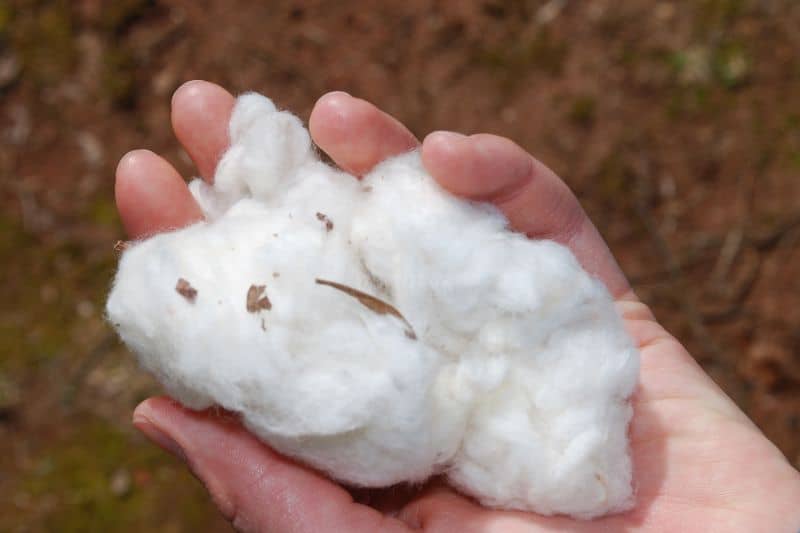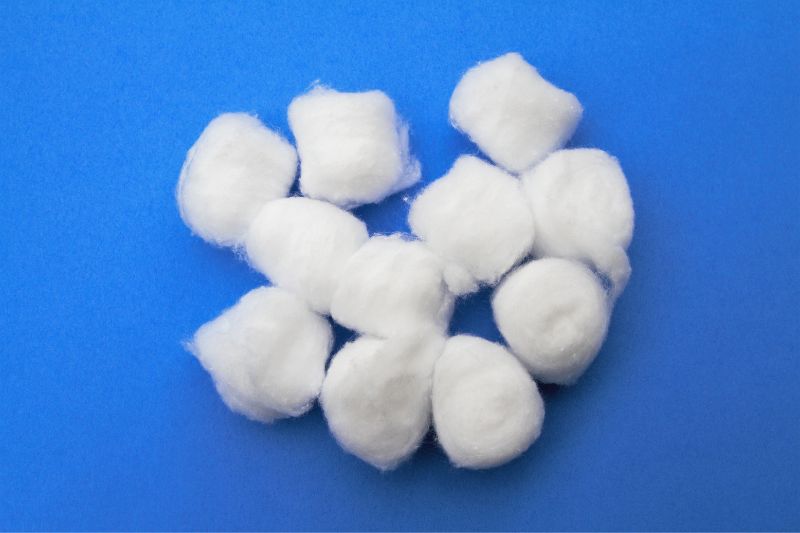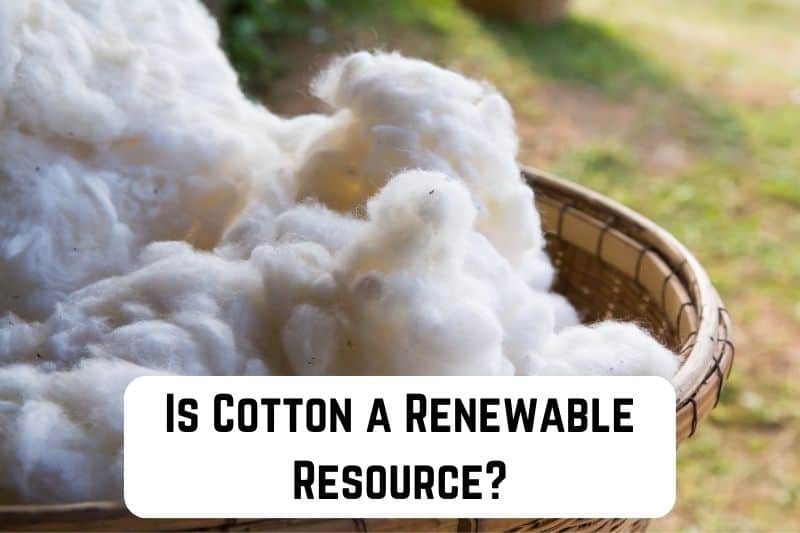Knowing the difference between renewable and non-renewable resources is crucial in today’s environmentally conscious world. Making wise judgments in daily life and business that promote a sustainable future is based on this understanding.
Millions of people are clothed by cotton, a soft and adaptable fiber that continues to be a mainstay in the textile business. However, as discussions about sustainability become more prevalent worldwide, a crucial query arises: Is cotton a renewable resource? In this article, we will examine the issue of whether cotton qualifies as a renewable resource.
Read: Is Linen Sustainable? (Read to Find Out)
What is Cotton and How is it Made?
Since cotton is a staple fabric, its constituent fibers come in various lengths. The natural fibers of Gossypium, a genus of cotton plants, are used to make cotton. Cotton is a soft, fluffy material mainly made of cellulose, an insoluble organic molecule essential to plant structure.
The cotton plant requires plenty of sunlight, a protracted period of frost-free weather, and regular rainfall. The portion of the cotton plant that develops in the ball—the covering for the fluffy cotton fibers—is referred to as “cotton.” Soft and long-lasting fabric is made by spinning cotton into yarn and weaving it together.
Cotton’s constituent fibers vary in a range of lengths because it is a staple fabric. Cotton is made from the natural fibers of the Gossypium genus of cotton plants. The main component of cotton, which is soft and fluffy, is cellulose, an insoluble organic substance vital to plant structure.
The cotton plant needs consistent rainfall, extended frost-free periods, and sunshine. “Cotton” refers to the part of the cotton plant that grows inside the boll, which wraps the fluffy cotton fibers. Weaving cotton into yarn and sewing it together creates a durable, soft cloth.
You can detect tiny, hair-like threads if you closely examine your cotton balls, socks, or trousers. Cotton fibers are made up of a single cell. Most cell types are so small that you must use a strong microscope to observe them. However, the unaided eye can see cotton fibers for up to two inches.
In actuality, cultivated cotton fibers have the greatest cell lengths of any plant. In just thirty days, cotton fibers reach most of their enormous length. In a fertilized cotton blossom, they start as microscopic cells. They load the developing seed pods to the brim a month later.
Individual strands are twisted and overlapped to create threads for fabric. Since they can be woven into finer threads and require less overlap than shorter fibers, longer fibers are considered more valuable than shorter ones.
Higher thread counts, or more threads per square inch of cloth, can be achieved using thinner and finer threads. Since materials with a high thread count are regarded as fine linens, their price is more than that of less airy and delicate materials.

Is Cotton a Renewable Resource?
Since cotton comes from a plant that can be harvested and replanted yearly, it is a renewable resource. As long as appropriate agricultural techniques are followed to guarantee soil sustainability and health, cotton can be grown and sustained year after year.
Since cotton can be grown year-round, it is a renewable plant. Cotton is grown by farmers in their fields and harvested when the season is appropriate. But cotton’s sustainability depends on how it’s made and whether it can be renewed.
Sustainable methods are emerging to reduce their influence on the environment. Recycled fibers and organic cotton are renewable substitutes that sustainable fashion manufacturers increasingly use.
Organic cotton encourages biodiversity and lessens the use of toxic chemicals by eliminating synthetic pesticides and fertilizers. Recycled fibers revitalize worn-out clothing, cutting waste and preserving resources.
Since cotton can regrow each year, it can be regarded as renewable; nevertheless, genuine sustainability requires adopting environmentally friendly techniques, such as using recycled or organic ingredients and assuring ethical sourcing throughout the production process.

Sustainable Cotton Alternatives
Finding cotton substitutes that might lessen the environmental impact of cotton production is crucial since cotton production has a negative influence on the environment and has become unsustainable. There are numerous options for cotton substitutes, each with unique advantages.
Wool
Wool is an ideal substitute for cotton because of its superior thermal resistance and capacity to maintain warmth even in damp conditions. This makes wool a wonderful, high-end material for several types of clothing. Cotton is quickly catching up to wool regarding sustainability and environmental friendliness. Wool is historically known for these qualities.
Flax
Compared to cotton, the flax plant needs significantly less water to develop. Retting is the method used to extract flax fiber, and it uses a lot less water. For most of those unaware, flax is used to make linen, an incredibly soft, breathable fabric with antibacterial qualities.
Hemp
Hemp outperforms cotton in several ways and has consistently proven superior. To begin with, hemp requires a lot less area to cultivate than cotton. Producing more in a much smaller area is possible.
Furthermore, hemp requires much less water than cotton—more than 9,000 liters, to be precise! And as if it could get better still, hemp plant-based fabric has an extended lifespan. Hemp keeps its toughness and resilience when wet, although cotton tends to weaken.
Ramie
Although the textile industry is unfamiliar with this plant, it merits more study. The Ramie plant produces fiber that is far more absorbent than cotton and has the sheen of silk. The fabric’s only drawback is its labor-intensive nature because of the gummy resin that must be removed.
Due to a slowdown in cotton exports, there was previously an elevated demand for fiber but insufficient supply to meet the demand. Nevertheless, Ramie produces a breathable and pleasant product, so there’s no question that all the effort was worthwhile.
Environmental Impact of Cotton
In the textile business, cotton is a widely utilized material and the most common natural fiber used to make clothing. It is one of the most important cash crops in the world and makes up about 33% of all fibers utilized in textiles. Though it costs the environment, cotton production is essential to the economy. Here are a few environmental impact of cotton.
Global Warming
Cotton production produces approximately 220 million metric tons of carbon emissions annually. A substantial quantity of synthetic fertilizers used on regular cotton cause nitrous oxide to be released into the atmosphere.
Thirty-one times more powerful than carbon dioxide, nitrous oxide is a significant greenhouse gas. The usage of heavy chemicals and other unsustainable actions like deforestation increase greenhouse gas emissions.
Water Consumption
Cotton requires a lot of water to grow and manufacture. A cotton t-shirt requires around 2,700 gallons of water to make. An individual can survive on that much water for 2.5 years. Cotton textiles with dyes look fantastic, but the global water consumption for fabric dyeing is approximately 5 trillion gallons annually.
Cotton fiber requires about 20,000 liters of water to make one kilogram. Some claim that cotton uses the most water resources from all agricultural commodities. This need is unsustainable in most cases.
Genetic Modification
Scientists have genetically altered certain cotton species to boost productivity and profitability to possess particular traits. Cotton that has undergone genetic engineering has advantages, such as resistance to herbicides and insects.
At least forty types of weeds have become resistant to glyphosate due to the extensive use of improper pesticides in the cotton industry. Additionally, it has made certain lepidopteran insects resistant to the cotton’s protective genes. Additionally, there’s a chance that wild crops will acquire genetically engineered genes.
Read: Are Fog Machines Bad For The Environment?
Is Cotton Biodegradable?
Cotton is undoubtedly biodegradable. Because it is a natural substance, cotton decomposes entirely. This implies that cotton will disintegrate whether placed in a composting heap or container or even left to do it naturally.
Clothing made entirely of cotton may be recycled and repurposed to make valuable materials like insulation for homes because cotton is biodegradable. Since cotton is a naturally occurring crop grown in fields, it decomposes entirely.
Cotton is biodegradable in aerobic and anaerobic environments; however, its breakdown rate in the latter will be significantly slower than in the former or a compost pile or bin. As such, it has a remarkable advantage over other artificial materials. It also implies that cotton will eventually biodegrade in landfills, so we don’t need to worry about it.
But instead of tossing cotton away, try to reuse, recycle, or compost it to keep it out of landfills. However, it’s comforting to know that, should it or its fabrics wind up in landfills, they won’t accumulate and add to the methane release that results in the build-up of greenhouse gases.
FAQ’s
Is all cotton compostable?
You might assume that all cotton can be composted because cotton is a natural material that breaks down quickly. Unfortunately, it isn’t true. Cotton goods, including apparel, are often processed with chemicals that reduce their biodegradability. Therefore, even though cotton may be composted, many cotton products cannot.
How sustainable is cotton production?
Despite being renewable, cotton cultivation can harm the environment because it requires a lot of water, pesticides, and land. Sustainable cotton farming techniques lessen these effects.
What makes cotton renewable?
Since it is derived from a plant that can be sown again and harvested in a subsequent growing season, cotton is renewable. Its development cycle makes cultivation sustainable.
Conclusion
Cotton can produce a superior biodegradable, renewable, and sustainable fabric. However, the need for inexpensive cloth from fast fashion brands, the textile sector, and consumers has forced manufacturers to use less expensive, less sustainable methods. Nonetheless, it is undeniable that all of the alternatives covered in the paper are sustainable.






